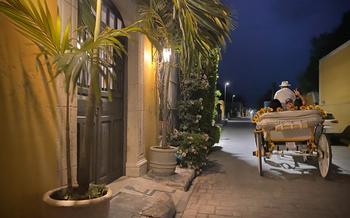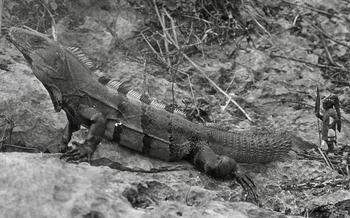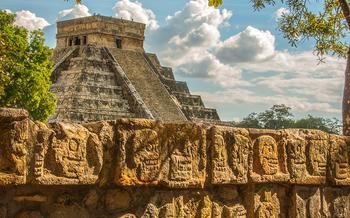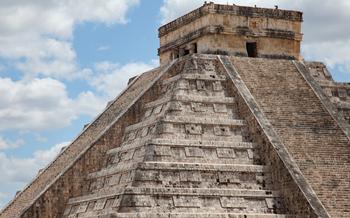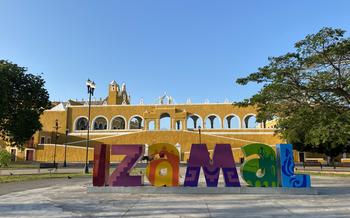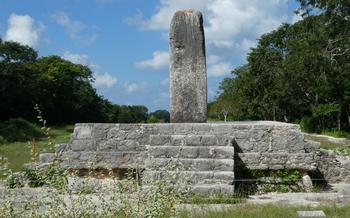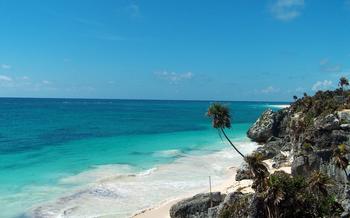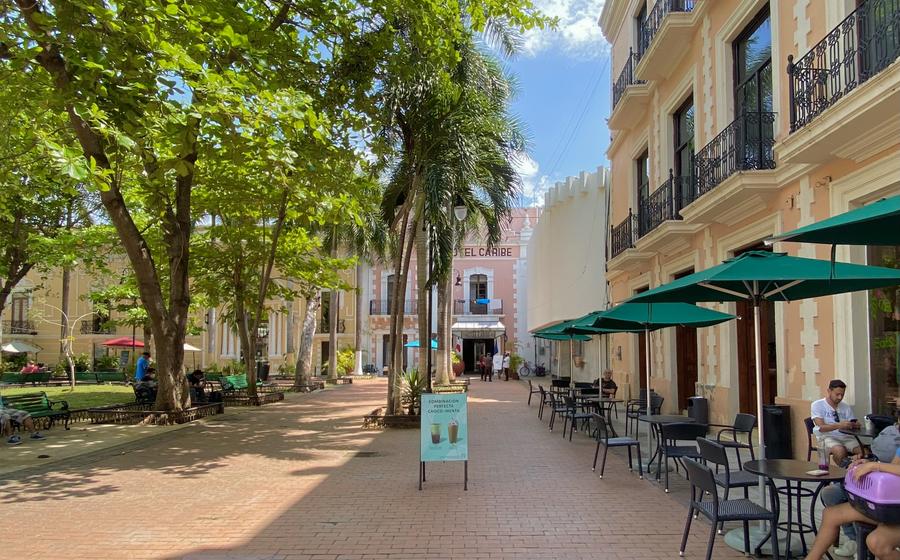
Cenote Kikil
- Getting to Cenote Kikil
- Exploring the Cenote
- Sunbathing by the Cenote
- Exploring the Surroundings
- Camping near the Cenote
- Local Legends and Myths
- Photography at Cenote Kikil
- Respecting the Environment
- Guided Tours
- Insider Tip
Getting to Cenote Kikil
Visiting Cenote Kikil requires careful planning to ensure a safe and enjoyable experience.
- 🕒 Best Time to Visit:
- Aim to visit during the dry season (November to April) for the best weather conditions.
-
Avoid the rainy season (May to October) when heavy rains can make the roads impassable.
-
🚌 Transportation Options:
-
Car Rental:
- Rent a car for the ultimate flexibility and freedom to explore the Yucatan Peninsula at your own pace.
- Driving directions to Cenote Kikil are readily available online.
-
Organized Tours:
- Book a guided tour that includes transportation to and from your hotel.
- This option is ideal if you prefer a hassle-free experience and want to learn more about the cenote's history and significance.
-
👟 Appropriate Clothing and Footwear:
- Pack comfortable clothing that you can get wet in, such as a swimsuit or shorts and a t-shirt.
-
Wear sturdy, closed-toe shoes or water shoes for navigating the rocky terrain around the cenote.
-
🔦 Essential Items:
- Bring plenty of water to stay hydrated, especially in the hot Yucatan sun.
- Carry a flashlight or headlamp for exploring the cenote's caves and tunnels.
- Consider packing a waterproof camera to capture your underwater adventures.
Exploring the Cenote
Descending into Cenote Kikil is like entering a hidden chamber of natural wonders. Through a narrow opening, you'll carefully make your way down, greeted by a breathtaking spectacle of stalactites and stalagmites. These mesmerizing rock formations, sculpted by time and water, create an awe-inspiring backdrop for your exploration.
As you immerse yourself in the crystal-clear waters, you'll discover a world teeming with life. Schools of colorful fish dart through the depths, while turtles bask in the warm sunlight that filters through the jungle canopy. Take a moment to float peacefully, surrounded by the tranquil beauty of this underground oasis.
Capture the magic of your experience with breathtaking photographs. The natural light filtering through the cenote's opening creates a kaleidoscope of colors that will leave you with lasting memories of your time at Cenote Kikil.
Sunbathing by the Cenote
After a refreshing swim in the crystal-clear waters, bask in the warm Mexican sun by the cenote. Find a comfortable spot on the rocky ledges or sandy shores, spread out your towel, and let the sun's rays gently caress your skin. Close your eyes and listen to the soothing sounds of nature—the gentle rustling of leaves, the chirping of birds, and the distant calls of monkeys. Inhale the fresh air, scented with the fragrance of tropical flowers, and feel your worries melt away as you relax in this tranquil paradise.
Reapply sunscreen regularly to avoid sunburn and protect your skin from the intense Yucatan sun. Take a break from sunbathing to rehydrate with fresh water and replenish your energy levels with healthy snacks. Immerse yourself in the serene ambiance, let the natural beauty of the cenote soothe your soul, and create lasting memories of your visit to this hidden gem.
Exploring the Surroundings
Beyond the refreshing waters of Cenote Kikil, the surrounding landscape offers a wealth of hidden treasures waiting to be discovered. Explore the intricate network of caves and tunnels that snake through the limestone, leading to secluded chambers and hidden passages. Observe the diverse plant and animal life that call this natural oasis home. With a keen eye, you may spot colorful tropical birds flitting through the trees, shy lizards basking in the sun, or even glimpse a family of playful monkeys swinging through the branches. Learn about the local flora and fauna from a knowledgeable guide who can share fascinating insights into the unique ecosystem that thrives around the cenote. Capture stunning Instagram-worthy shots of the surrounding landscape, showcasing the harmonious blend of nature and history that makes Cenote Kikil a truly special place.
Camping near the Cenote
The allure of Cenote Kikil extends beyond daytime exploration. For those seeking an immersive experience, camping near the cenote offers a unique opportunity to connect with nature under the starry sky. Designated camping areas provide a safe and convenient base for adventurers to pitch their tents and embrace the tranquility of the surroundings.
As darkness descends, the cenote transforms into a mystical haven. The gentle chirping of crickets and the distant hooting of owls create a symphony of sounds that lull campers into a peaceful slumber. A campfire crackles, casting flickering shadows on the surrounding trees, inviting stories and laughter to fill the air.
Roasting marshmallows over the open flames, campers can indulge in sweet treats while gazing up at the celestial tapestry above. The Milky Way stretches across the sky, its ethereal glow illuminating the night. Shooting stars occasionally streak across the canvas, igniting wishes and dreams in the hearts of those who witness them.
Waking up to the gentle rays of the morning sun peeking through the trees, campers can savor the tranquility of the cenote before the crowds arrive. A refreshing dip in the crystal-clear waters invigorates the senses, preparing them for another day of exploration and adventure.
Local Legends and Myths
Cenote Kikil holds a special place in Maya mythology and is intertwined with ancient legends and myths. According to local lore, cenotes were considered gateways to the underworld, Xibalba, where the Maya believed their ancestors resided. The ancient Maya revered cenotes as sacred places and often performed rituals and ceremonies near their waters.
One legend tells of a beautiful Maya princess named Ixchel who was chosen as a sacrifice to appease the gods and bring rain to the parched land. Ixchel was lowered into the depths of Cenote Kikil, her long hair flowing behind her like a shimmering veil. As she descended, her tears mingled with the water, creating a sacred connection between the cenote and the heavens.
Another myth speaks of a hidden city beneath the cenote, inhabited by a race of water spirits known as the Aluxes. These mischievous creatures were said to protect the cenote and its secrets, playing tricks on those who dared to venture too close.
Respecting local beliefs and customs is essential when exploring Cenote Kikil. Visitors are encouraged to learn about Maya mythology and the significance of cenotes in their culture, fostering a deeper appreciation for the sacred nature of these natural wonders.
Photography at Cenote Kikil
The beauty of Cenote Kikil is not just limited to its refreshing waters and stunning geological formations; it is also a photographer's paradise. The natural light that filters through the opening of the cenote creates a magical ambiance, making it an ideal spot for capturing breathtaking shots.
Whether you're an amateur photographer or a professional, Cenote Kikil offers endless opportunities to unleash your creativity. With underwater photography, you can capture the vibrant marine life and the intricate underwater structures. Above ground, the lush vegetation and the surrounding landscape provide a stunning backdrop for your shots.
Experiment with different angles and perspectives to create unique images that showcase the cenote's unique beauty. Play with the light and shadows to enhance the depth and drama of your photos. Don't forget to share your stunning captures on social media to inspire others to visit this hidden gem and appreciate its natural wonders.
Respecting the Environment
The pristine beauty of Cenote Kikil is a gift that should be cherished and preserved for generations to come. As visitors, it is our responsibility to minimize our impact on the delicate ecosystem of the cenote. Avoid using harsh chemicals or detergents when swimming or cleaning, as these substances can harm the aquatic life. Dispose of waste properly in designated bins to prevent pollution.
Educate yourself and others about the importance of protecting the cenote. Share information about the unique features and significance of the cenote to raise awareness and inspire others to respect and preserve it. By working together, we can ensure that Cenote Kikil remains a pristine oasis for years to come.
Guided Tours
Venturing into Cenote Kikil with a knowledgeable guide offers a rewarding experience. These experts can unveil the hidden stories, geological wonders, and ecological significance of the cenote. They'll lead you through the intricate network of caves and tunnels, pointing out unique features and formations that might otherwise go unnoticed.
Choose a reputable tour operator that prioritizes safety and sustainability. Look for companies that follow responsible tourism practices, minimizing their impact on the environment and supporting local communities.
During the tour, your guide will provide insights into the history, geology, and ecology of the cenote. Learn about the ancient Maya's reverence for cenotes, the formation of stalactites and stalagmites, and the diverse plant and animal life that call the cenote home.
Follow the instructions of your guide to ensure a safe and enjoyable experience. They will advise on safe swimming areas, point out potential hazards, and ensure that you have a fulfilling and educational journey.
Insider Tip
If you want to experience the magic of Cenote Kikil without the crowds, plan your visit for early in the morning or late in the afternoon. These times offer a serene ambiance, allowing you to fully appreciate the beauty of the cenote and its surroundings. As the sun rises or sets, the light dances on the water, creating a picturesque scene that will leave you breathless. Take advantage of the tranquility and capture stunning photographs without distractions. Remember, the cenote is a natural wonder that should be respected and preserved, so be mindful of your impact and leave no trace of your visit.

